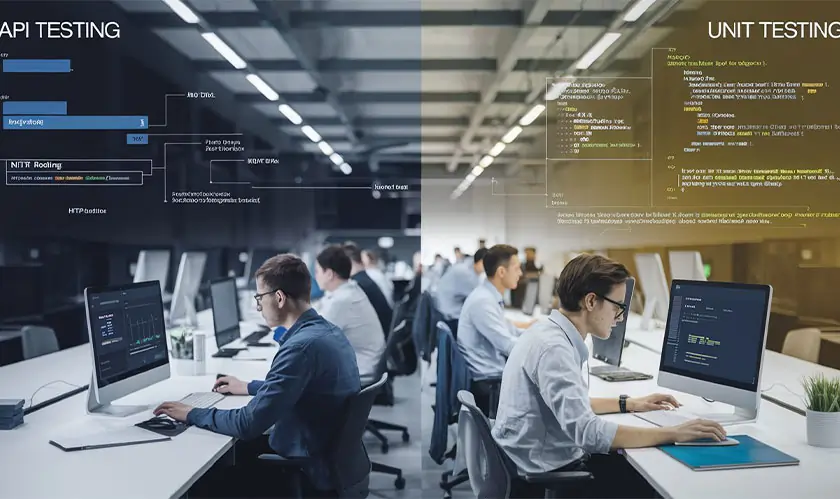Home Technology Automation What Are The Main Differences ...
Automation

CIO Bulletin
13 September, 2024
When it comes to software development, understanding the different types of testing is necessary to ensure that everything runs smoothly. One of the key differences between API testing and unit testing is that API testing focuses on the interactions between various systems, whereas unit testing targets individual components. In other words, API testing checks if different software systems communicate and perform well together. In contrast, unit testing verifies that each specific part of the code works correctly on its own.
Another major distinction lies in their scope. API testing is more comprehensive as it involves checking the application's interfaces' overall functionality, security, and performance. For example, this could include examining how the system handles different inputs or maintaining secure communication between servers. On the other hand, unit testing involves scrutinizing each small unit of code separately, usually by the developers, to ensure that each part performs as expected.
Finally, both methods serve unique purposes in the development cycle. Using automated testing of Application Programming Interfaces allows you to validate the behavior of APIs without manual intervention efficiently, guarantees strong system integration, and helps catch errors early, thus saving time and effort in future stages. Conversely, unit testing helps maintain code quality by catching bugs in individual units, making pinpointing and fixing issues quickly easier.
API Testing and Unit Testing serve unique purposes in the software development process. While API Testing focuses on ensuring the correctness of the application's interfaces, Unit Testing hones in on individual components to verify their functionality.
API Testing examines the application programming interfaces to guarantee they meet functionality, performance, and security expectations. It verifies that APIs respond correctly to requests from client applications. Automated tools are commonly used to automate these tests, allowing you to assess different scenarios and edge cases. API Testing covers end-to-end functionality, including data validation, API endpoints, error handling, and response times. This type of testing helps identify issues such as slow performance, incorrect outputs, and security vulnerabilities in your APIs.
Unit Testing involves testing individual components or modules of your code. The goal is to provide each part functions correctly in isolation. Typically performed by developers, Unit Testing is one of the earliest stages of testing. Using frameworks like JUnit or NUnit, you can automate Unit Tests to save time and guarantee consistency. Unit Testing focuses on business logic, ensuring each function, procedure, or method works as intended. This approach helps catch errors early in development, making it easier to fix bugs before they impact the larger system.
The scope of API Testing is broader, encompassing the API itself and how it interacts with other parts of the system. It checks multiple layers, including database and server performance, which gives you a comprehensive view of the application’s behavior under various conditions. By contrast, Unit Testing is more granular, zooming in on individual code units. It’s like checking each puzzle piece separately before putting them all together. This difference in scope means Unit Tests are quicker to execute, but API Tests provide a more complete picture of the application’s functionality.
When comparing API Testing and Unit Testing, it's important to understand their specific goals, techniques, and roles in the software development lifecycle. Each type of testing has distinct requirements and purposes.
API Testing focuses on verifying APIs' functionality, reliability, performance, and security. This provides that the API meets its specifications and can handle different scenarios.
Unit Testing aims to verify that individual units or components of the software work as expected. Developers write these tests to confirm the correctness of each function or method.
The main objectives of API Testing include:
For Unit Testing:
For API Testing, you often use tools like Postman and Apache JMeter to automate and measure responses from API endpoints.
In Unit Testing, tools such as JUnit and NUnit are popular. You test each piece of code in isolation from others to verify its correctness.
API Testing Techniques:
Unit Testing Techniques:
Performance testing for APIs involves evaluating API performance under different loads and guaranteeing it meets speed and scalability requirements. Security testing identifies vulnerabilities like SQL injection or cross-site scripting (XSS).
Unit Testing does not typically involve performance or security testing. Instead, it focuses on the correctness and reliability of individual units.
API Performance Testing:
Security Testing:
API Testing usually occurs during the integration and system testing phases. It confirms that different software components interact correctly and that the API functions as expected from a user's perspective.
Developers primarily perform Unit Testing during the development phase. It helps catch bugs early, promote code quality, and make later stages of testing easier.
API Testing Role:
Unit Testing Role:
Understanding the differences and specific goals of API Testing and Unit Testing can help you choose the right approach for your software development needs. Each plays a necessary role in delivering high-quality, reliable software systems.
API testing and unit testing play important roles in maintaining software quality. Each serves a unique purpose and focuses on different levels of the software.
API Testing:
Unit Testing:
Understanding the differences between these testing types helps efficiently manage software development and ensure strong performance. Consider integrating both to achieve comprehensive coverage and improved reliability in your projects.







